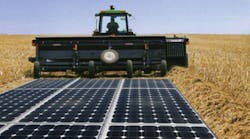This Power Plant blog post was written by Frank Schmidt, chief technology officer of EnOcean.
15 years ago, the term “energy harvesting” was not born and only very few scientists were thinking along these lines worldwide. Today, things have changed significantly. Energy harvesting wireless solutions have made their way into several fields of application including building and industrial automation or smart home. The principle of harvesting energy from the surroundings to power wireless sensors, switches and even actuators allows flexible data collection even at places that are difficult to reach. In other words, wherever cables and batteries are not practicable or cause too much maintenance effort.
Energy harvesting wireless technology is just starting to unfold its potential. Currently, there are several technical developments going on to allow new applications and functionalities. These not only affect the energy harvesters but almost each component of the platform. We will see some of them already in 2014. The next technical steps in energy harvesting radio communication are:
· Longer range radio connection – The next generation of battery-less radio technology wirelessly transmits data via a distance of more than four miles – and enabling new applications with high range requirements outside of the building. The increased energy needed for the long distance communication can be realized by significant progress in the other building blocks at the same time.
· Higher efficiency harvesters – Electro-mechanical converters operate very robustly and are extremely versatile. New types of mechanical energy harvesters will make use of the energy of flowing gases and liquids in particular. Fig. 1 shows an electro-mechanical harvester.
· Light will remain one of the most frequently used energy sources. Next product generations will combine better efficiency solar cells with improved performance under low light conditions, in particular. While the limit of operation is light intensities of about 100 lux at 5% efficiency today, next generation solar cells based on organic material or dye-sensitized technology will operate down to 10 lux light intensity with more than 10% efficiency.
· Combined with lower leakage and higher capacity energy storage, solar-powered devices will run in complete darkness for several months in a year.
· Temperature differences as energy source are only at the beginning of their possibilities. One new option is to harvest energy from temperature differences between day and night for outdoor applications.
· Lower energy consumption – The lower energy consumption a device has, the better the chances are for applying energy harvesting strategies successfully. So, for new applications, especially for the most critical functions such as sleeping current of the sensor nodes and receiver current, it is inevitable to reduce the energy demand significantly. Recent developments have shown a factor of 10 lower timer currents for the next generation of sensor modules already.
· Higher capacity energy storage – Besides the energy need, research is evaluating improved storage components. The target is to store harvested energy from weeks to several months without new ambient energy impulses. In the future, there will be battery-less sensors that can “sleep” for a much longer period of time, keeping their energy until an incident wakes them up to measure and send signals.
These developments will open up many areas for energy harvesting wireless solutions, including alarm systems in dark environments, indoor applications in weakly illuminated areas, structural health monitoring as well as environmental monitoring.


